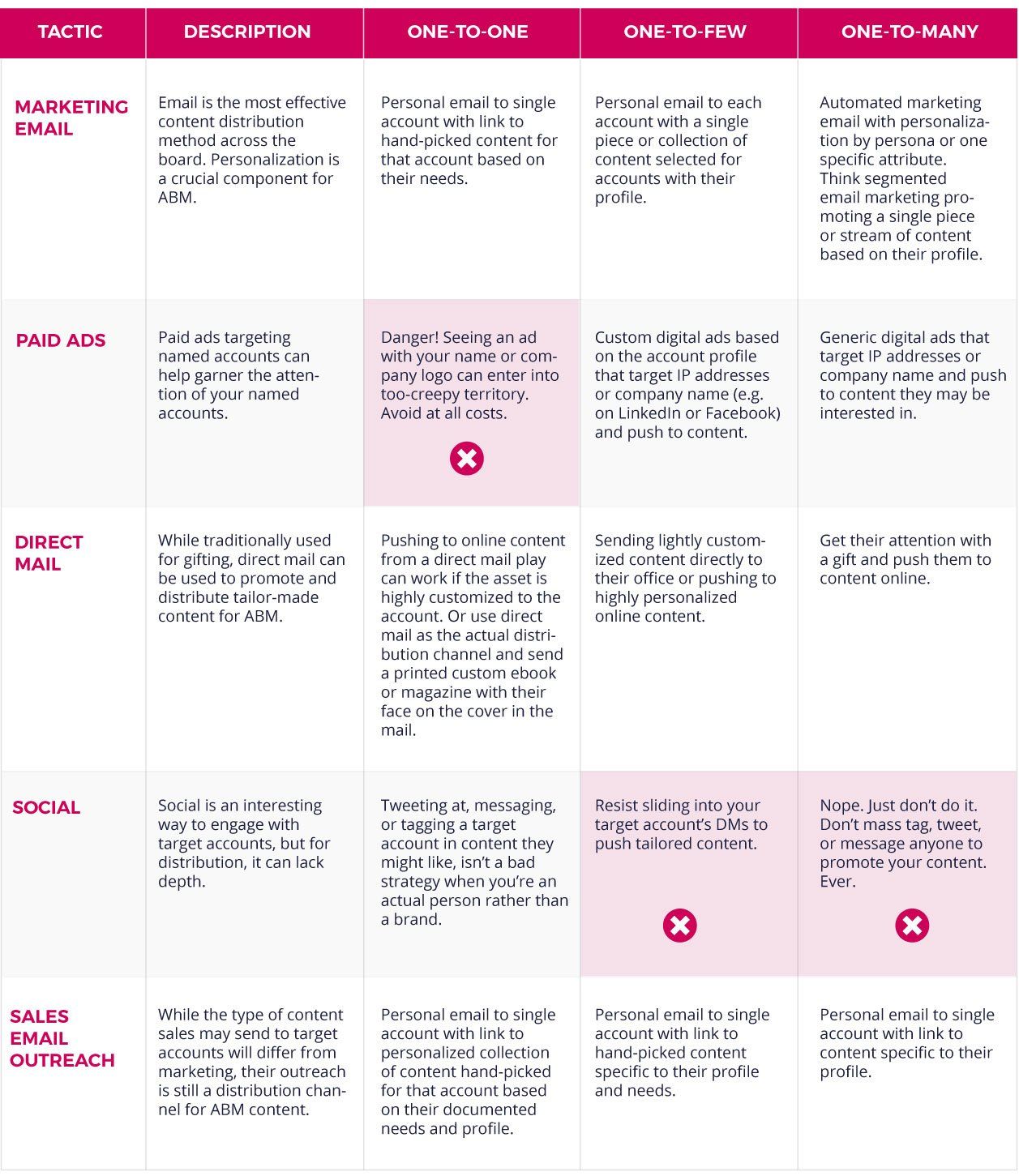
Sales and marketing. The best of friends, and the worst of foes. Ultimately, both of these teams are responsible for the growth of the company, and yet, we find ourselves in a situation reminiscent of the book, Men Are from Mars, Women Are from Venus: a relationship full of tension and friction! But there are ways to make the relationship better. One approach is account-based marketing (ABM).
Why the friction?
Frankly, it shouldn’t be that difficult, right? Sales and marketing work in the same company. We share the same business goals. We market and sell the same products. In some organizations, we even report to the same manager or belong to the same group. We should be on the same team. Well, the devil is in the details.
Fundamentally, sales and marketing differ on:
- Department goals: Sales focuses on revenue, while marketing focuses on demand generation and brand recognition or both.
- Long-term and short-term priorities: Sales is in the trenches focusing on monthly and quarterly quotas, while marketing needs to focus on mass brand awareness and facilitating prospects throughout the purchase funnel, which takes more time than just one month or one quarter.
- Resources and support allocation: Sales processes and methodology are more linear, while the purchase cycle goes back and forth between the top and the middle of the funnel before customers make the final decision on a purchase. Sales resource allocation is based on sales processes, while marketing outreach tends to be channel-based or purchase journey-driven.
If these concerns and differences are not discussed and addressed between sales and marketing on a timely basis, the misalignment and friction will continue. The key is to rally the teams with the same goals or priorities. ABM is a natural path to align between sales and marketing.
What is ABM, anyway?
ABM is strategic and personalized marketing outreach and engagements with people at target accounts through close collaboration between sales and marketing. In general, there are 3 tiers of ABM:
- 1st : One-to-one: work with the account team to develop and implement highly customized programs for individual accounts.
- 2nd: One-to-few: work with sales teams to focus on a few accounts that share business imperatives.
- 3rd: One-to-many: target verticals or segments with common needs.
Once you decide on the tier and select accounts, marketers need to create account-specific communications to reach out to the collective individuals of the accounts or specific verticals/industry segments.
Here are the recommended steps to craft an ABM communications plan:
- Gather account-specific insights.
- Map content to the account-specific purchase journey based on account insights and tiers.
- Create and source a mix of original and curated content based on content gaps.
- Craft a marketing communications plan.
- Tie success metrics to sales goals.
The key ingredients of this process are account-specific insights, content planning, and success metrics.
Step 1: Gather account-specific insights
Understanding your target audience and buyer’s journey is essential for any marketing campaigns, and the ABM approach is no exception. For ABM to work, marketers must have a strong knowledge of the target accounts and the collection of individuals that you are going after. You need to build account-specific knowledge. During the account-selection process, sales usually has information about specific accounts. The information can be broken into five categories:
-
Firmographics:
Attributes about a company, such as size, number of employees, annual revenue, industry vertical, growth, and number of locations.
For marketers: Firmographics can help you to understand the names of the team, organization structure, target individuals’ preferences, pain points, personalities, and more.
-
Technographics:
An account’s current and future technology (such as tech stack) and its organization environment.
For marketers: Technographics can guide you on messaging and content planning, especially helping you understand the current technology you use and how your company’s technology and products can help them. You may also work with your sales team to identify additional areas where your sales team can provide value.
-
Purchase intent:
Behavior indicators showing an intention to buy. For example content downloads and participation in forums or social media.
For marketers: You can gauge the purchase intent with content downloads, website behaviors, email engagement, and marketing-automation data.
-
Engagement history:
The record of interaction with the company—sales, web analytics, CRM, marketing-automation data, and sales-rep activities.
For marketers: You can gather additional account and vertical information from other systems in your company.
-
Sales team’s input:
Engagement history and experience.
For marketers: Collect additional information by talking to your sales team directly. Use their points of views to validate or invalidate your assumptions. Your job is to study, analyze, and transfer the data into knowledge and insights that you can act on to customize and craft your content planning for the target individuals or verticals.
Step 2: Map content to the account-specific purchase journey based on account insights and tiers
Once you have a solid grasp of these individuals or cluster of accounts, you can weave their needs into your content customization and you can segment your list and send relevant content to multiple accounts who share similar challenges.
-
1st – One-to-one ABM:
You need to go above and beyond for these individuals, understand their personal tastes and preferences to create outreach exclusively for them. Don’t limit yourself to just content; think of other marketing channels, especially special events and VIP invitations. There must be close communication between sales and marketing. You need to be in the loop for your account teams’ game plans.
-
2nd – One-to-few ABM:
For this tier, you target a cluster of accounts with similar technographics, firmographic data, or profiles. For instance, if they use the same tech, fit the same persona, and have the same challenges, you can create a direct-mail campaign with content that speaks to all those accounts with some level of personalization. This ABM approach enables you to apply the same creative idea or the same play to a set of accounts. You can map content based on their purchase journeys or sales-enablement efforts. Understanding the salespeople’s game plan can also help marketing determine the relevant content for this approach.
-
3rd – One-to-many ABM:
You can segment your accounts by broader industry segments or verticals. Many marketing organizations already do vertical-specific marketing campaigns as part of their marketing outreach. To make this type of ABM work, you can further segment the accounts or refine your content plan within the same verticals by using data from firmographics, technographics, purchase intent, engagement history, and sales’ input. Even though it’s a one-to-many approach, it’s still important to work closely with the sales team and solicit their feedback on your outbound and inbound marketing communications.
Step 3: Create and source a mix of original and curated content based on content gaps
While mapping content to an account or a vertical-specific purchase journey, you may discover that you need to create new content for personalization. It can get expensive to create new content whenever there is a gap or whenever an account requires exclusive personalization. When you discover gaps, you can either create or source content using a content-curation platform such as Curata, PublishThis, Scoop.it, Feedly and more. Personalization often comes from a mix of original and curated content. Arming yourself with account-specific insights and inquiries based on firmographic and technographic data can help you identify a selection of content from which to personalize your outreach.
Step 4: Craft a marketing outreach plan
With a tiered approach, account insights, content knowledge, and mapping, you can craft your marketing-outreach plan using a mix of existing marketing channels. While you may still use the same familiar channels, you can now better decide which channels to dial up or dial down. Marketing has to present the outreach plan to the sales team and help them understand what they will need to do to follow through. Sales should provide feedback to marketing on what channels work for their accounts given their knowledge of their customers or prospects. In addition to sales’ feedback, it’s a matter of budget and resource allocation. Engage contacts on the channels where they are most active, posting the messages and content they want. This table from Uberflip’s blog post provides useful guidance on the channels to use for different tiers of ABM.
Check out the Content Distribution Tactics for ABM from Uberflip.
Step 5: Tie success metrics to sales goals
ABM requires marketers to work closely with the sales team, a great way to reduce friction between sales and marketing. Since this approach is account-based, the metrics must tie to sales goals: opportunities generated and revenue closed. Sales and marketing need to agree on success metrics in advance. It’s also important to agree on the sources and tools that will be used to track the progress. Often, marketing will track the metrics using marketing automation tools, yet sales pulls information from CRM or other systems. Although the systems may be integrated, the numbers may not be the same. It’s important to identify the tracking source.
Again, Uberflip’s blog post: Lesson 5- Measuring the Success of ABM, presents several metrics examples:
Engagement:
- Target account website traffic
- Event attendance
- Ad conversion
- Webinar attendance
Sales Efficiency:
- The rate of booking meetings (per account, by activity) on your target list.
- Opportunity creation rate
- Revenue closed from target accounts
Deal Velocity:
- Number of days for target accounts to close vs average
Average Customer Value:
- Size of the deal vs average
It’s possible to build alignment with your sales team
There are multiple ways to reduce friction between sales and marketing. ABM is just one of them.
Marketing and sales can also work together on customer events or implement a joint co-marketing plan.
The ultimate goal of marketing is to bring in new customers. Pick one initiative and work together. Make an effort—it starts with you.




